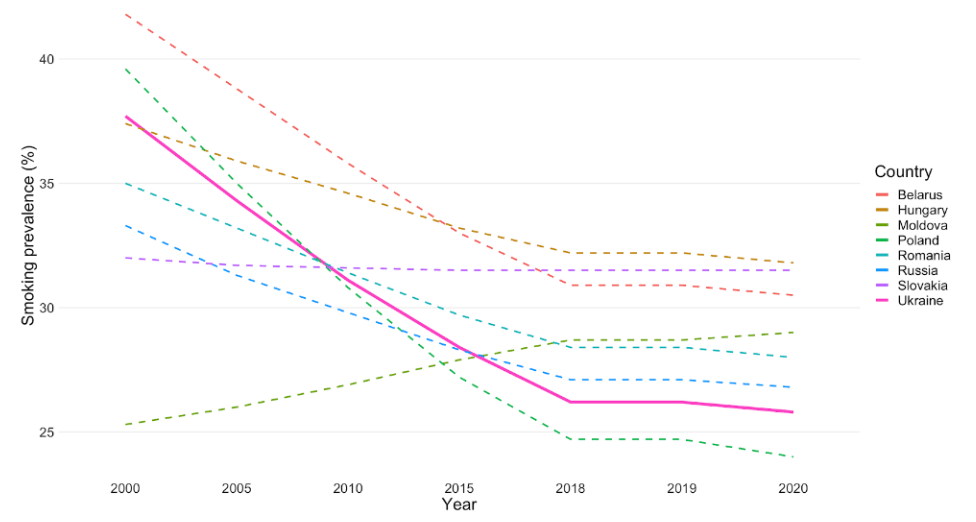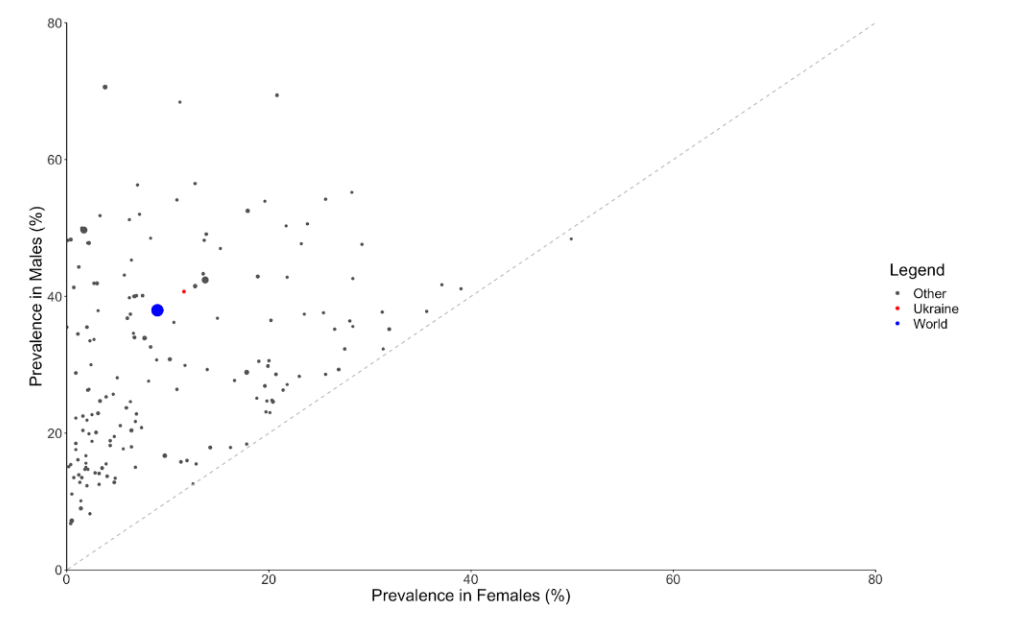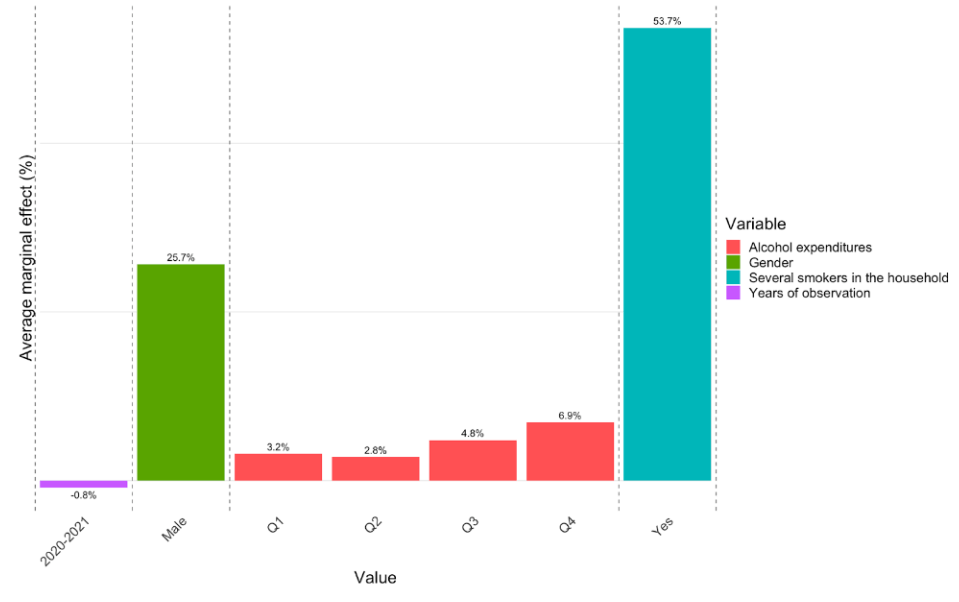What are the underlying factors that make people smoke? What are these factors in Ukraine? Do our social connections, socio-demographic indicators, alcohol habits, and COVID-19 impact whether we smoke?
The global prevalence of smoking continues to present formidable challenges to public health and economies on a worldwide scale. Extensive research consistently emphasizes the detrimental impact of smoking on individual well-being, contributing to the development of chronic conditions such as cancer, cardiovascular diseases, and respiratory disorders. Moreover, the economic ramifications stemming from smoking-related healthcare expenditures, decreased productivity, and premature mortality are truly staggering. Effectively tackling this pervasive crisis necessitates a comprehensive understanding of the underlying factors that drive individuals to smoke.
As of 2020, the prevalence of tobacco use in the world remained alarmingly high, affecting approximately 22.3% of the global population. These disheartening figures translate to over 8 million deaths worldwide directly attributed to smoking, encompassing 1.2 million non-smokers who tragically fell victim to the pernicious effects of secondhand smoke. In Ukraine, approximately 25.8% of the adult population smoke. This is higher than the world average, although slightly below the majority of our neighboring countries (figure 1).
Figure 1. Prevalence of current tobacco use in Ukraine and its’ neighbors (% of adults 15 y.o. and older)
Source: World Development Indicators
Despite ongoing efforts to combat smoking and reduce its prevalence, the habit persists as a distressingly common behavior. Unraveling the underlying motivations behind smoking is crucial in order to address this persistent issue. Numerous factors play a role in shaping individuals’ smoking habits, encompassing gender differences, socioeconomic status, social interactions, and the intriguing connection between smoking and COVID-19. Gaining a comprehensive understanding of these multifaceted dynamics holds the potential to offer valuable insights for the development of effective strategies aimed at decreasing smoking rates and fostering healthier communities.
Factors influencing smoking
Gender differences have long been acknowledged as a significant determinant of smoking behaviors. This trend is consistently observed on a global scale, where men tend to have higher smoking rates compared to women. This pattern holds in Ukraine, reflecting the broader gender disparity in smoking prevalence (figure 2).
Figure 2. Smoking prevalence in men vs. women, 2019 (%)
Source: World Development Indicators. Note: size of the dot is proportional to population of the country
Obviously, gender is not the sole determinant of smoking behavior. Socioeconomic status encompassing educational attainment, income level, and occupation, plays a crucial role in shaping an individual’s likelihood of smoking. Extensive research conducted across different countries consistently reveals a higher prevalence of smoking among individuals with lower socioeconomic advantages. This underscores the importance of addressing social disparities and implementing targeted interventions to reduce smoking rates within disadvantaged populations.
Furthermore, social interactions have a substantial impact on the spread of smoking. Studies demonstrate that individuals are more inclined to smoke when surrounded by peers who smoke. Additionally, having a spouse who smokes increases the likelihood of individual smoking. This social multiplier effect becomes more pronounced as the number of smokers in one’s social circle increases. Understanding these social dynamics can inform anti-smoking campaigns and interventions designed to disrupt the cycle of smoking within communities.
Moreover, the relationship between alcohol consumption and tobacco use is closely intertwined. Research indicates that individuals who consume alcohol are more likely to smoke, and heavy drinkers are particularly prone to heavy smoking. This association operates through both interindividual influences and situational interactions, where individuals who engage in both behaviors tend to do so together. Recognizing this connection is vital for developing comprehensive strategies to address co-occurring alcohol and tobacco addiction.
The COVID-19 pandemic has further shed light on the consequences of smoking. Recent studies indicate that smokers face an elevated risk of severe illness when infected with COVID-19, including a higher mortality rate. Furthermore, findings from South Korea and Poland suggest that smokers have been highly responsive to communication regarding the risks of smoking in relation to COVID-19, likely due to the immediate health consequences associated with both smoking and COVID-19 infection.
Data
The data utilized in this study was derived from the annual survey of the State Statistical Service in Ukraine focusing on the living conditions of households between 2018 and 2021. The dataset comprises cross-sectional data collected at both the household and individual levels, encompassing various variables such as income, employment status, education level, expenditures, and more. This rich dataset provides valuable insights into the socioeconomic characteristics and circumstances of the surveyed households and individuals.
To investigate the smoking prevalence in Ukraine and its determinants, we used a logit model. All the above-mentioned factors were considered, including the potential impact of COVID-19, which was captured through proxy variables representing the years 2020 and 2021.
Results
The estimation results were as follows. First, the proxy variable capturing the potential impact of the COVID-19 outbreak on smoking showed a negative coefficient, indicating a possible decline in smoking prevalence during 2020-2021. However, the effect was relatively small, making it challenging to differentiate from the overall declining trend in smoking prevalence in Ukraine.
Additionally, our analysis revealed a positive association between alcohol expenditures and smoking prevalence. Higher expenditures on alcohol as a share of household spending is consistently correlated with higher smoking rates. This finding aligns with previous research, highlighting the role of alcohol consumption in shaping smoking behavior.
Our study showed a particularly pronounced effect of social interactions. Presence of several smokers in the household had the largest positive impact on the probability of individual smoking. This finding underscores the profound role that social interactions play in shaping smoking behavior. Indeed, a social environment of smokers “normalizes” smoking making an individual more likely to acquire the habit.
Among other factors, senior age, higher education and self-employment were associated with a lower likelihood of smoking.
Figure 3. The average marginal effect of main variables estimation
Source: Author’s calculations
Conclusions
Our study revealed significant positive associations between alcohol expenditures, the presence of multiple smokers in the household, and smoking prevalence, highlighting the influential role of alcohol consumption and social interactions with smokers on smoking behavior.
Expectedly, demographic and socioeconomic variables, including gender, age, education, and employment status, demonstrated significant associations with smoking behavior. Male individuals exhibited a higher likelihood of being smokers, while older age groups, higher education levels, and self-employment were associated with a lower likelihood of smoking. These findings suggest the importance of considering social, economic, and educational factors in developing effective tobacco control policies.
The effect of COVID on the probability of smoking was negative but small and thus cannot be distinguished from the general trend of declining smoking prevalence in Ukraine.
Given the positive association between alcohol expenditures and smoking prevalence, coordinated public health campaigns should address the harmful effects of both alcohol and tobacco use. Possible policies include propaganda of harmful impact of alcohol and smoking and increase of excise taxes for both alcohol and tobacco.
It is important to acknowledge the limitations of this study, such as the absence of information on the direct impact of COVID-19 on smoking prevalence and the focus on traditional cigarette smoking, excluding alternative smoking methods. Additionally, the study did not include an assessment of social networks and workplace environments, which could influence smoking behavior.
Annex
Table 1. Estimation results
| Variable | Value | Average marginal effect (%) |
| Settlement type | ||
| Small city | -2.28% | |
| Rural | -3.24% | |
| Age | ||
| 36-59 | 2.96% | |
| 60+ | -3.97% | |
| Gender | ||
| Male | 25.65% | |
| Education | ||
| Higher education | -2.94% | |
| Labor force employment status | ||
| Employer, self-employed | -2.62% | |
| Pensioner | -3.77% | |
| Other | -2.25% | |
| Sport activity | ||
| Yes | -1.29% | |
| Medical help | ||
| Yes | -1.42% | |
| Several smokers in the household | ||
| Yes | 53.66% | |
| Years of observation | ||
| 2020-2021 | -0.84% | |
| Income quartiles | ||
| Q2 | -1.97% | |
| Q3 | -3.53% | |
| Q4 | -6.53% | |
| Alcohol expenditures | ||
| Q1 | 3.17% | |
| Q2 | 2.78% | |
| Q3 | 4.80% | |
| Q4 | 6.92% | |
| Healthcare expenditures | ||
| Q1 | -1.07% | |
| Q2 | -1.56% | |
| Q3 | -2.30% | |
| Q4 | -2.52% | |
Attention
The author doesn`t work for, consult to, own shares in or receive funding from any company or organization that would benefit from this article, and have no relevant affiliations





